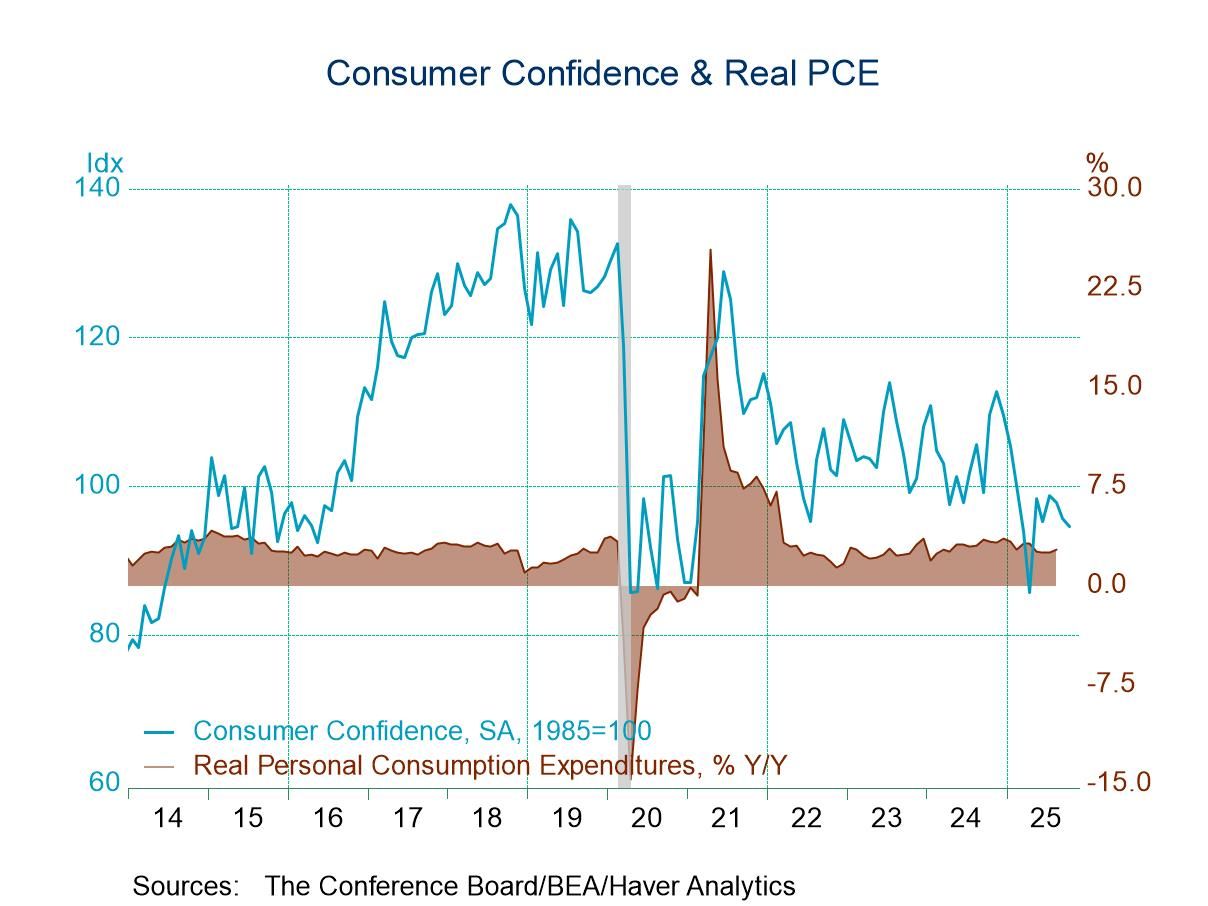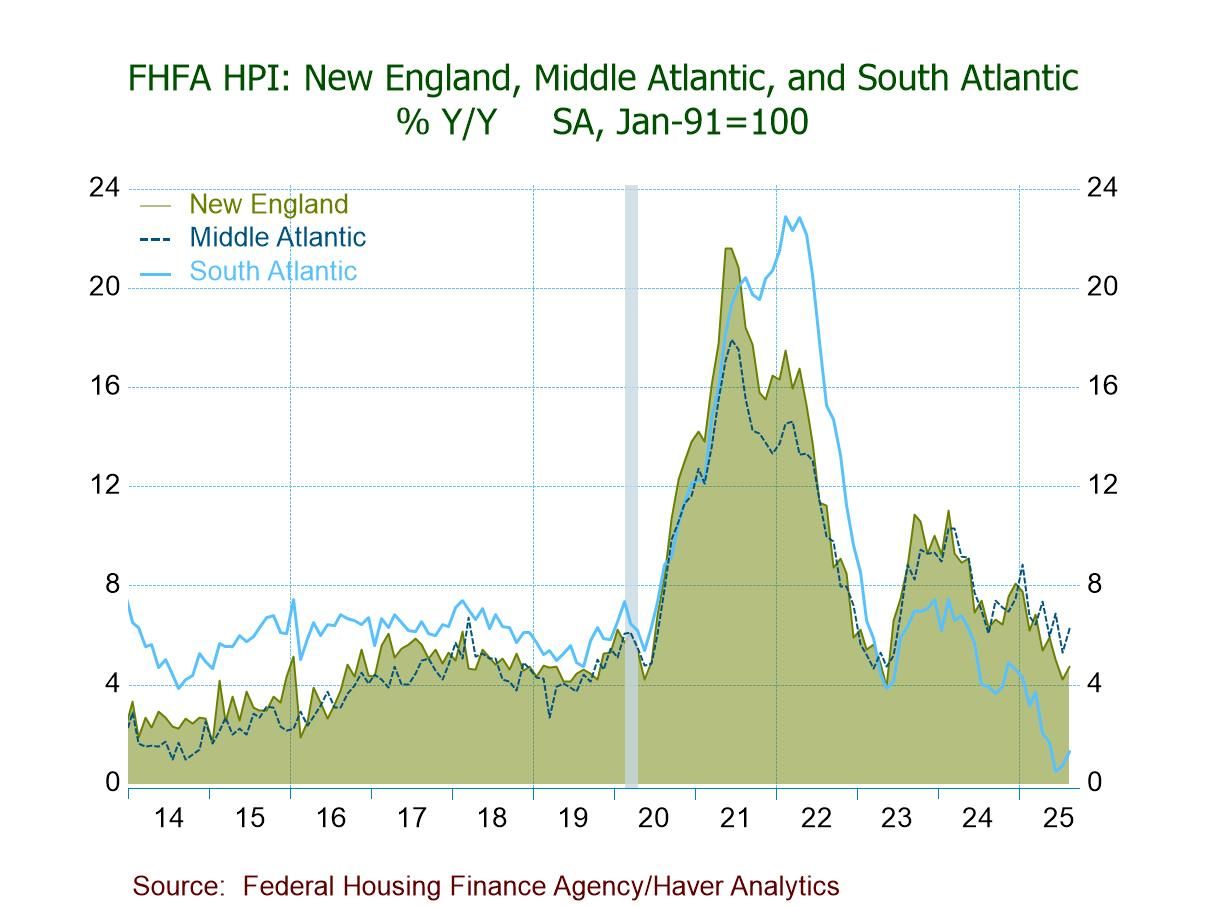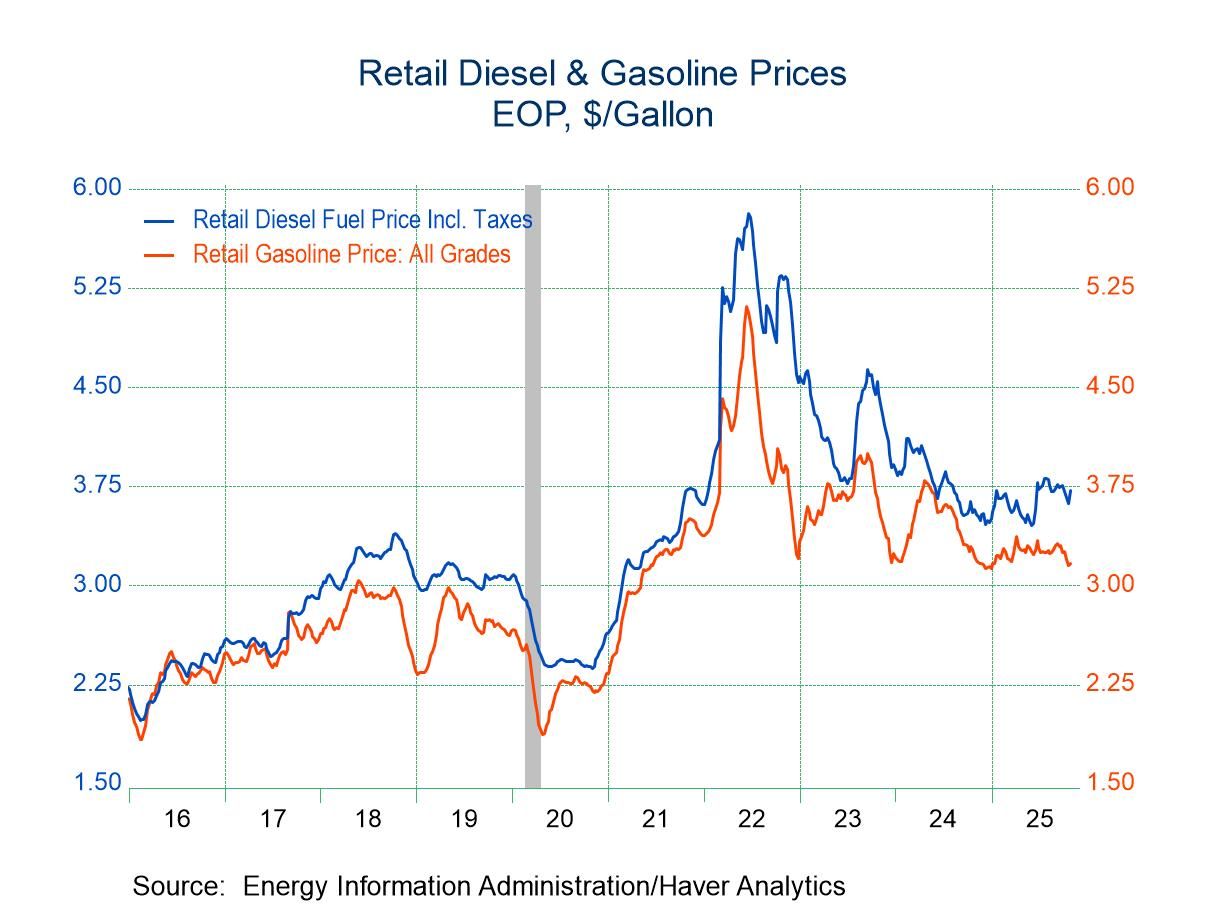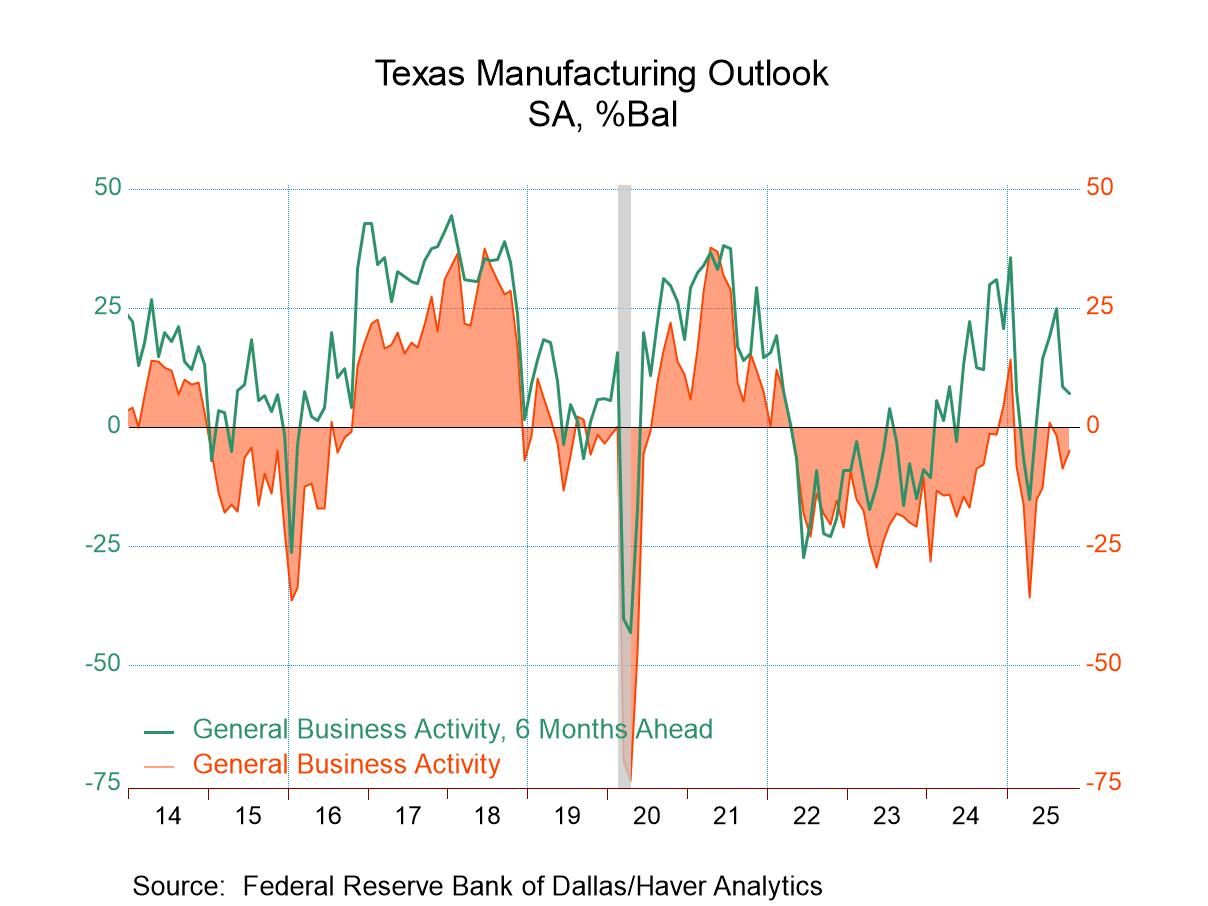 Global| Nov 04 2019
Global| Nov 04 2019Manufacturing PMI Remains Weak in and across EMU and EU
Summary
EMU manufacturing IP is declining in step with weakness in the manufacturing PMI The Markit manufacturing flash indexes are now replaced with their final gauges. Manufacturing in the EMU is slightly less weak than in its flash but it [...]
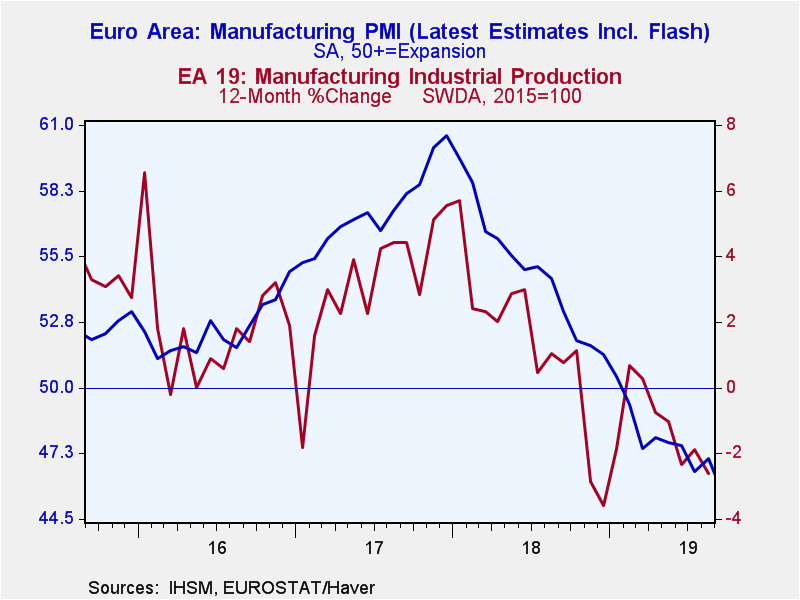 EMU manufacturing IP is declining in step with weakness in the manufacturing PMI
EMU manufacturing IP is declining in step with weakness in the manufacturing PMI
The Markit manufacturing flash indexes are now replaced with their final gauges. Manufacturing in the EMU is slightly less weak than in its flash but it is still weak; it is still contracting but it does improve by a small amount from its September value.
Of the nine EMU members reporting separate gauges, four of them report gauges below 50 that imply contraction in the sector. And three of the four largest EMU economies, Germany, Italy and Spain, report out manufacturing declines in October, with France, the second largest EMU economy the exception, reporting an increase. In September five countries had diffusion readings below 50 and in August six had readings below 50. Among this group, the number of EMU members reporting contraction has been steadily diminishing. But the (weighted) EMU index still fell from August to September. And even though it rose from September to October, the October value is below the August value. The weighted EMU gauge is still the best gauge to see how the PMIs are performing in EMU, but the country level data also matter since member nations make policy in the EMU.
While there may be some stabilization creeping into the monthly data, the sequential averages for 12-months to six-months to three-months show a considerably more stable view of the number of declining economies ranging from 5 to 6 over those periods, sequentially without any real trend.
The position of the PMI index relative to '50' answers a question about sector expansion or contraction. There is also the question of momentum. In October momentum fades in five of nine EMU members, the same as September. But in August only Ireland loses momentum month-to-month. The sequential average values show broad loses in momentum with declines in the EMU averages period-to-period in each case: three-months, six months and 12-month. Country level declines occur in at least seven of nine countries for each period. Momentum is clearly still being lost even if contraction per se is not spreading. That means that countries where output has switched from contracting to expanding are outliers not leaders.
Non-EMU countries
Looking at the non-EMU countries, a group of European countries plus China, shows a lot of similarity to what is going on in the European grouping. The non-EMU grouping shows more outright contraction with PMIs below '50' in seven of nine cases in October, six of nine in September, and five on nine in August. The proportion with output declining is rising monthly in the lower panel. There is no clear 'trend' for monthly deceleration as only three decelerate in October compared to 6 in September and only three in August; that pattern is actually similar to the results for EMU members, a group that also has the highest incidence of deceleration monthly in September. The sequential averages show seven non-EMU countries with PMI averages below '50' for their three-month a well as six-month averages with just two below '50' over 12 months. That shows the same progression to contraction as EMU countries but less output contraction over 12 months. However, in terms of momentum the non-EMU panel of countries shows a very similar swath of weakening observations including all of the 12-month comparisons to their average of 12-months ago.
The queue percentile standings show similar results as well. The average percentile sending in each panel of the table is in its low 20th percentile. Each grouping has two of their number on their roughly 4.5-year lows with several other members having much higher rankings. In both cases, the dispersion among rank values is in the neighborhood of 30%.
I did not cherry-pick these countries to create this similarity; these are simply two groups I have tracked based on getting a high number of EMU reporters and a number of mostly European countries. I look at Asia in a separate take. What I think this table demonstrates is how robustly the manufacturing sector weakness is spread across the world's major trading nations, in this case especially Europe.
U.S.-China conflictThe U.S. trade conflict with China drags on. There are some 'encouraging statements' being made, but we know to keep them at arm's length. What the table shows in that impacts of the trade war have been generated far and wide and they do affect different countries differently. So I'm wary of saying that the impact of the trade conflict is uniform. It is not but it is robustly spread creating scattershot weakness of a similar sort in difference places. I do present simple averages for each of the two groups in a two line segment at the table bottom. These comparisons show that over the past year and on shorter horizons the main impact has been an impact causing a minor degree of contraction on average across all regions; the 12-month averages show contrarily only the barest of bones increase.
Today China is saying that there will be no 'promise fatigue' in its pledge to open its markets. This is in response to an import fair in China where the EU says that China has to make rapid and substantial improvements.
While many are critical of the Trump pressure on China and call Trump a 'protectionist' for slapping on tariffs meant to bring China to the bargaining table, his bold leadership on this matter has allowed and encouraged others like the EU to come out of the shadow to lodge their own complaints. Prior to Trump and his bombast about unfair trade, there had been a sleazy 'conventional wisdom' that called the past regime 'close enough to free trade.' And many urged Trump not to tinker with it. But he did. And he has emboldened others to speak out about China's unfair practices. Trump may even get a new trade deal with China as a result, one that will be better and fairer. He also already renegotiated NAFTA in a way to close the loopholes that allowed Mexico to distribute its NAFTA access to the US marketplace globally. By increasing domestic content rules, the attractiveness of investment in Mexico to gain access to the U.S. has been cut off. The new trade deal (if it is passed) encourages Mexico to develop and get the gains for trade for itself, instead of just skimming off a small portion on the back of the interests of foreign multinational corporations that might operate there.
At a time that Democrats are trying to get people paid more for doing the same basic work, Trump is trying to change the equation so that better and higher-pay jobs will remain or be relocated in the U.S. Which of those two things sounds more like a permanent solution to you? Trump has not acted like a Republican on trade. He has done things over trade that Democrats should have done years ago. His trade actions essentially expose how little Democrats have been looking after workers' interests. It is astonishing that a Republican president is attacking U.S. multinational corporations abroad and trying to muscle them to bring operations back home. Obama 'bailed out' GM and it still farmed out its electric car to be made overseas. Trump has cut corporate taxes and reduced regulations to try to make production in the U.S. more viable as he also has provided verbal pressure.
I understand that Trump is not poster-boy for goodness. I understand that many dislike him intensely for other reasons. I understand the Democrats (alone) are trying to remove him from office. But his positions on trade are as positive and as refreshing as his demeanor can be nasty. Yes, I argue that Donald has had a good side. No, that does not make him a 'good person.' But there are aspects of the Trump administration that are doing some very positive things. Politics is tricky business. It has been said that contents of sausage and politics should not be discussed in polite company. And yet nowadays we find all kinds of things being discussed in public as discourse becomes increasingly less polite. I will report here something a philosophy professor of mine once said. It was on the question of the ends and means, a famous proposition attributed to Machiavelli. So, does the ends justify the means? The answer is that if it doesn't, you have the wrong ends. So do you still think Trump's trade policy is bad? Or should we all just give ourselves raises and live la Dolce Vita? Why not raise the minimum wage to $30/hour…or more? (To see why not, go here to read the SNL script that lampoons Jimmy Carter on inflation (Inflation Is Our Friend!); it is both funny and educational.)
Robert Brusca
AuthorMore in Author Profile »Robert A. Brusca is Chief Economist of Fact and Opinion Economics, a consulting firm he founded in Manhattan. He has been an economist on Wall Street for over 25 years. He has visited central banking and large institutional clients in over 30 countries in his career as an economist. Mr. Brusca was a Divisional Research Chief at the Federal Reserve Bank of NY (Chief of the International Financial markets Division), a Fed Watcher at Irving Trust and Chief Economist at Nikko Securities International. He is widely quoted and appears in various media. Mr. Brusca holds an MA and Ph.D. in economics from Michigan State University and a BA in Economics from the University of Michigan. His research pursues his strong interests in non aligned policy economics as well as international economics. FAO Economics’ research targets investors to assist them in making better investment decisions in stocks, bonds and in a variety of international assets. The company does not manage money and has no conflicts in giving economic advice.



